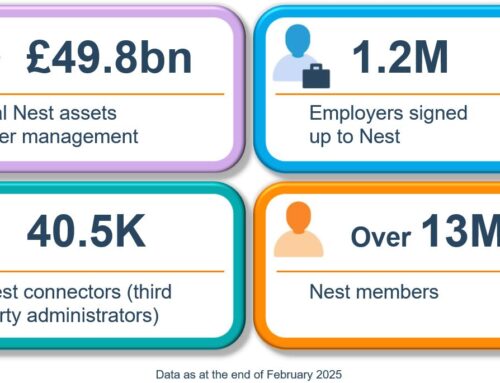Broadly speaking, it’s universally accepted that saving for retirement’s a good thing for people to do. Being financially able to stop working when we want and continue to maintain a reasonable, or better, standard of living through our later years is desirable.
So, given this universal truth, it’s surprising how little we’ve historically done as individuals to take steps to help achieve this.
Even the act of setting up a pension has been viewed as challenging. In 1997 only 55 per cent of people working in the UK were in a workplace pension*. Of this 55 per cent, more than four fifths were in defined benefit schemes. Many were in the public sector and were enrolled into the scheme by their employer under the terms of their contract of employment when they joined the business.
By 2012, just before the commencement of the auto enrolment programme, the number of people in workplace pensions had fallen to just over 46 per cent of the working population. This reduction of around one sixth was largely driven by a fall in the number of workers in defined benefit schemes. The number of workers in such schemes had dropped to only 28 per cent.
From 1997 to 2012 the perceived solution to this problem was largely to educate and inform employees. This was viewed as a way of empowering them to make their own decisions about pension savings and presenting them with a wide range of choices to enable them to select their own preferred options. The evidence above suggests that this approach didn’t even manage to maintain participation rates, let alone increase participation to desired levels. Against this backdrop it’s perhaps unsurprising that there was universal parliamentary support for the introduction of auto enrolment. Auto enrolment was seen as introducing a ‘nudge’ into saving for large sections of the UK workforce.
Given pensions are so important why is it that we need to be nudged into starting to save and now we have been, are all our problems solved?
Behavioural Economics can help us understand why we need to be nudged. In their seminal work on the subject, ‘Nudge’ (published in 2008), Richard Thaler and Cass Sunstein set out five key reasons why people fail to make good decisions or indeed any decisions at all! When we consider these in the context of pensions, it’s not hard to see why people particularly struggle in this field:
- Separation of choice and consequence – people are poor at making decisions that carry a cost today for a benefit in the future. Our self-control tends to make us ignore the longer term for more immediate pleasure.
- Degree of difficulty – generally we struggle with decisions we perceive to be complex or difficult, often choosing to procrastinate rather than risking making the wrong decision.
- Frequency – the old saying goes ‘practice makes perfect’ and while it’s a questionable statement in itself, it suggests that the more we undertake a task, the more comfortable we become with it. So, broadly speaking, the better we get at it. Infrequent tasks and challenges tend to be far more difficult for us than those we do every day.
- Feedback – a key part of forming successful behaviour is feedback on our performance so far and how we can improve. Long-term products like pensions often have unclear goals at the outset. So, how can we provide appropriate feedback to support good decisions?
- Knowing what we like – for many decisions we seek products similar to those we have already bought and liked. For example, Spotify recommends bands who resemble those we’ve already listened to. However, with pensions and other similar products we generally don’t have a list of preferences to start from or a way to compare new products to those we’ve used before.
What we can now see is that the introduction of a nudge through the auto enrolment legislation has done a lot to address the issue of worker participation in pensions. By 2017 participation was up to nearly 73 per cent, a 60 per cent increase on the pre-auto enrolment levels of 2012. The rise can be almost wholly attributed to DC schemes, where participation has risen from less than 10 per cent in 1997, to 17 per cent in 2012 and 43 per cent by 2017. Defined benefit membership remains at the 2012 rate of 28 per cent.
So, we now know we can successfully nudge people into saving and help them avoid the difficulties around choosing how and where to save. Through the provision of default investment funds, we can also nudge them into suitable investments, so they don’t have to make those difficult choices too. Experience so far shows us that when people invest with a fund chosen for them by their scheme, nearly all members remain in that fund. At NEST, over 99 per cent of our members are still saving in the fund chosen for them by our trustees.
However, while auto enrolment is helping solve the participation challenge, the change from defined benefit to defined contribution schemes for the majority of savers is shifting the responsibility to members to take the risk for the outcome. They’re no longer offered a guaranteed income for life from their scheme. Instead they’re faced with a pot of money, a host of complex choices about what to do with their pot and the very real prospect that it simply may not be enough.
This presents problems that participation alone won’t solve.
A widescale review of NEST’s membership** tells us that currently, on a proportional basis, very few members opt to contribute more than the minimum percentage from their salaries. Unlike the vast majority of members remaining within the investment fund chosen for them, this is concerning, as we want members to think about whether they’re saving enough, so they can have a brighter future.
The phasing process, increasing the legal minimum contribution rates built into the auto enrolment legislation in April 2018 and 2019, is expected to drive up contribution rates across the board for these savers. However, the reality is that more mature savers, or those wishing to have a higher level of income in retirement, will need to do more to have a sufficient pot at retirement to satisfy their needs.
So, for those people who might need to do more than the minimum, the question is how can we help them, and do we come full circle to the old method of engaging members through education and information? If so, how can we now make this work when it so clearly failed previously?
We first need to understand what the objective of member engagement is. This can include getting members to think differently, feel differently or take an action such as increasing contribution levels.
Experience and research shows that simply creating more communication won’t necessarily help increase engagement. This is because more awareness by itself doesn’t actually lead to a change in behaviour. As economist and psychologist, Herbert Smith said, ‘a wealth of information creates a poverty of attention’.
There’s so much information available today, with the use of the internet, mobiles and smart devices. So, we need to get our communications to stand out from all the information our members receive.
Behavioural scientists at Stanford University found that communication increases understanding, but emotion drives action. You need to appeal to people emotionally to drive change. A well-known investment manager and provider of corporate pensions created an app to help people see their future selves. This was without any contextual prompts linking to that individual’s circumstances. As a result, there was no change in usage. However, this contrasts to a 25 per cent increase in contributions when the same app was referenced in seminars about the importance of saving and how that future-self related to that individual’s circumstances. You need a call to action to connect to members emotionally and you then need to make it as easy as possible for them to act upon that emotional trigger. Personalisation can be a powerful tool for reaching people, if combined with simple defined choices for how to act.
The ultimate goal is to personalise pensions for every individual, to encourage engagement, as people respond better to this. You can personalise communications from the beginning. For example, when a member first joins, don’t ask them to increase contributions straight away, as they’ve just started a new job. Think about the optimum time to communicate your message and how you can personalise it to reach each member.
It’s therefore essential to think about those barriers to making decisions that are so clearly outlined for us in ‘Nudge’. We can use our ability to design simplified choices for people to respond to at the point of emotional motivation.
*Stats from Office for National Statistics Annual Survey of Hours and Earnings pension tables, UK: 2017 provisional and 2016 revised results
**How the UK Saves report 2018, NEST Insight and Vanguard. https://www.institutional.vanguard.co.uk/documents/institutional/brochure-how-uk-saves.pdf

